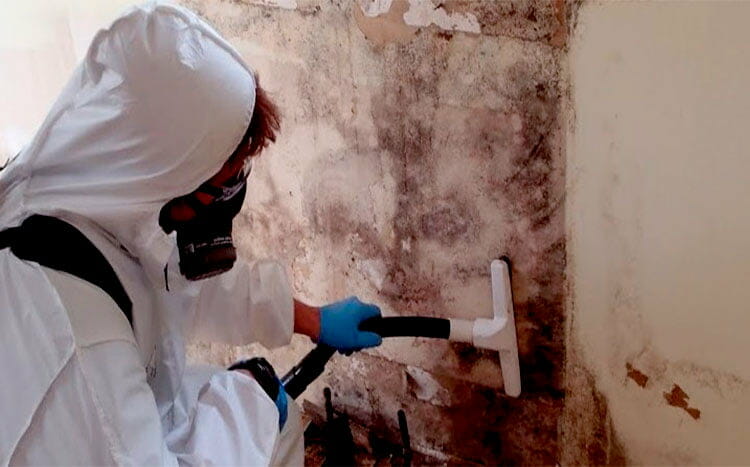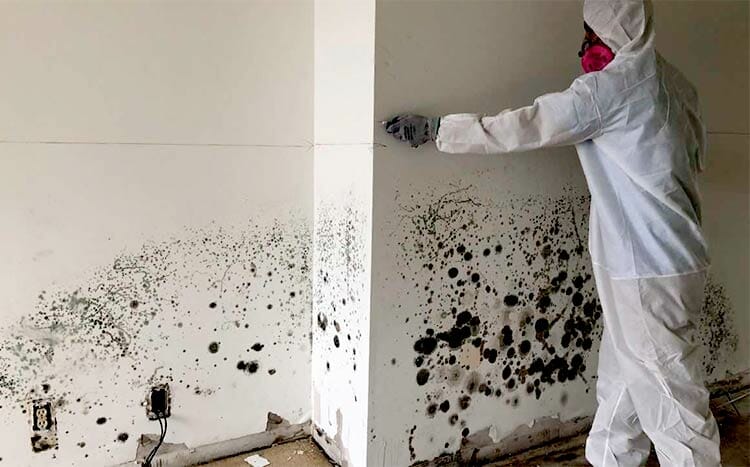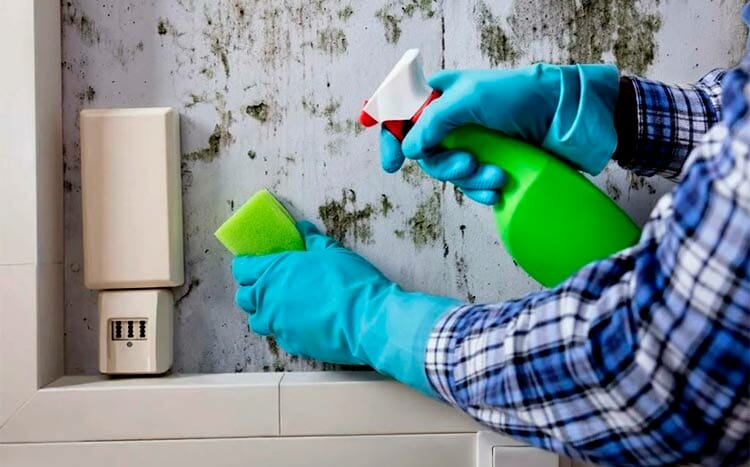Mold represents a major problem that all homeowners aim to avoid. When found, it’s critical to remove it promptly to prevent its continued spread.
Mold remediation typically takes 1 to 5 days to complete in residential buildings. However, certain factors that determine the removal process include the size of the area affected by mold, mold location and the surface it is growing on.
You should not attempt mold removal yourself. You should hire a professional for anything larger than 10 square feet (3 x 3 feet).
How to determine how long will mold remediation take?
Mold remediation can take between 1-5 days to complete depending on the following factors.
The size of the contaminated area.
- The mold location.
- The growth surface.
- The type of mold.
It would be best to ask your mold removal specialist how long the cleanup process would take. This can help you to plan alternative living arrangements if necessary.
The table below illustrates the different mold levels and their cleanup timeline.
| Mold Level | Contamination area | Health risk | Evacuate |
|---|---|---|---|
| 1 | Less than 10 sq. ft. | Low risk | No |
| 2 | 10 -30 sq. ft. | Low risk | No |
| 3 | Over 30 sq.ft. | Moderate risk | Advised |
| 4 | Over 100 sq.ft. | High risk | Yes |
| 5 | HVAC systems | High risk | Yes |

Can you stay in a house during mold remediation?
The decision to stay or leave your home during mold remediation depends on the level of mold contamination you have.
Low-level mold contamination
You can remove mold contamination in areas between under 10 to 30 square feet without evacuating your entire home. Sealing off contaminated areas from the rest of your home during remediation can prevent mold spores and dust particles from spreading to the rest of your house.
Severe contamination levels
However, you must evacuate your entire household in cases of severe mold contamination to avoid the dangerous health implications for you and your family.
The table below illustrates the mold levels that are safe to remain indoors during remediation.
| Mold Level | Contamination area | Remediation type | No of days |
|---|---|---|---|
| 1 | Less than 10 sq. ft. | DIY | Less than 1 day |
| 2 | 10 -30 sq. ft. | Professional | 1 - 2 days |
| 3 | Over 30 sq.ft. | Professional | 1 - 3 days |
| 4 | Over 100 sq.ft. | Professional | 2 - 5 days |
| 5 | HVAC systems | Professional | 3 - 5 days |
What happens during mold remediation?
EPA mold remediation guidelines offer a standard guide on mold remediation processes in homes and commercial properties. However, commercial mold remediation companies often provide a tailored approach based on the standard EPA guidelines to execute specific cleanups. Below is a guide on what to expect during mold remediation.
The preparation stage
- Workers put on their Personal Protective Equipment (PPE) to protect themselves from mold spores, contaminated material, and dust generated during the remediation process.
- Workers lay pipes, hoses and deploy equipment they use in removing mold.
- A plumber repairs the moisture source stimulating mold growth to prevent further contamination.
- Workers seal off the contaminated area from the rest of the house.
- Workers decontaminate all mold-damaged materials and remove them for disposal.
- Workers remove moldy removable items for cleaning and restoration.
Clean-up
- Workers wipe/scrub mold from mold non-removable surfaces with a damp sponge/cloth/paper towel and detergent solution.
- Mold contaminated surfaces can also be dry vacuumed with a HEPA-equipped vacuum to remove mold.
- Workers deep clean porous surfaces like wood to remove embedded mold by Bandung.
- Workers spray the area with an EPA-approved biocide to kill off all remaining mold.
- They leave the area and wait for 24 – 48 hours to allow the chemical work.
Disinfection
- Workers disinfect the area to remove any surfing mold.
- Workers perform encapsulation by coating the remaining mold spores with special treatments.
Drying
- The area is left to dry to remove all moisture.
- Workers can rig up fans or dehumidifiers to hasten the drying process.
Clean-up
- All the cleaned mold-contaminated items of value and furniture are disinfected and returned.
- Mold waste is safely disposed of.
- Workers remove, decontaminate, and store all equipment.
- They remove and decontaminate their PPE in decontamination chambers.
- They perform final visual checks for mold signs and odor, and they may perform an air particle test for mold presence.
- If the result is within acceptable levels, then the remediation job is successful.
How do you know if mold remediation is complete?
Performing a visual assessment of the remediated area for signs of new growth colonies is a quick way of determining if mold remediation is complete. However, there are several other mold signs that a simple visual assessment may fail to discover.
Here is a checklist that can help you determine mold remediation success more effectively.
- You must ensure the source of the mold problem is entirely resolved.
- You must finish the mold removal process.
- You must ensure that there is no more water damage in the remediated area. And there are no visible growing mold colonies and moldy smells after remediation.
- The house should be safe enough for residents to move and live in, without people developing symptoms of mold exposure.
- An independent test for mold should reveal acceptable levels of mold presence in the remediated area.

DIY v.s Hiring an Expert
Both professionals and DIYers can perform mold remediation. However, they should abide by the recommendations in EPA guide Mold Remediation in Schools and Commercial Buildings to safely and effectively remove mold. DIY mold removal can be impractical in situations where high levels of contamination and mold damage are present. Hiring a mold removal specialist is a sensible idea in such cases. But sometimes, it could also be your only option. According to the EPA, certain levels of mold contamination require professional (not DIY) remediation.
They include:
- Extensive mold contamination and damage in an area exceeding 100 square feet.
- Mold contamination within an HVAC system.
- Mold contamination and damage caused by sewage, floodwaters, or other contaminated water.
Do it Yourself

Pros
- You save money by performing mold removal yourself.
- You build invaluable mold removing experience, skills, and confidence.
- DIY mold removal also provides you with the opportunity to perform long-planned renovations of the contaminated area.
- You work at your leisure and don’t get in the way of anyone. More importantly, no one is getting in your way.
Cons
- Your rookie mistakes can enable the mold to spread to other parts of your home, worsening the problem.
- Your lack of knowledge about the correct personal protection equipment (PPE) can expose you to mold, triggering allergies and other health issues.
- Lack of the proper mold remediation equipment may result in incomplete mold removal.
- You can mishandle dangerous chemicals use to kill mold, exposing yourself to toxic fumes, or suffer skin burns and irritation as a result.
Hiring an Expert
Pros
- You enjoy a fast and professional mold remediation job.
- Higher chances of mold spores containment. Thus it is safer for you and your family.
- Professionals reduce the spread of mold by completely removing all the mold during the remediation process.
- Professionals offer advice on the best approach to mold cleanup.
Cons
- Hiring a professional can be expensive.
- You lose your privacy by having professionals in your home during the mold remediation process.
FAQ's
Yes, it can come back after remediation if the moisture build-up is allowed. E.g. water leak causing flooding in a recently remediated basement can attract mold growth within 48 hours.
Yes, you can. But only after you have successfully fixed all mold issues. Ask for and receive a guarantee from the mold remediation company as proof of quality to further secure the buyer’s trust.
No, mold remediation is not covered by the homeowner owners insurance policy. However, mold remediation cost is covered if an insured peril causes the mold damage.







